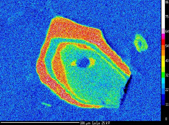Isotopic composition of accessory minerals
Magmatic complexity/isotopic zonation in apatite

The notion that all minerals crystallizing from a magmatic body have the same initial isotopic composition is one often repeated in undergraduate geology lectures. However, magma generation, evolution and emplacement, particularly in continental environments, is a very complex process and the idea of complete mineral isotopic homogeneity is only a generalization. Recent studies of Cenozoic volcanic rocks have shown that initial Sr isotopic variation is not uncommon in plagioclase (Davidson and Tepley, 1997; Tepley et al, 2000; Hora, 2003) and sanidine (Knesel et al., 1999) phenocrysts, with both increases and decreases in 87Sr/86Sr from core to rim observed. Comparable variations in initial isotopic ratios in plutonic feldspar are rarer, but have been reported (Waight et al., 2001; Gagnevin et al, 2005). There are also reports of O and Hf isotopic variation within single zircon crystals in granitoids (Kemp et al., 2007), suggesting that isotopic zonation is more common than thought in slowly cooled systems. Given the importance of potential isotopic heterogeneity, we began to investigate the isotopic composition of apatite in a series of ~ 300 Ma granitoids from southeastern USA. Our approach has been to compare whole apatite crystals with cores, rims, and whole-rock values. To analyze the cores of crystals we have followed two methods – physical abrasion to remove ~ 50% of the outer portion of the crystals, and acid leaching of the apatite to provide us with rim material (the leachate) and residual, core material (Dasgupta and Samson, 2008). Because leaching may not simply attack rims, but could dissolve inner portions of the apatite following microcracks or fission-tracks, we first annealed the apatite at 300ºC. This is hot enough to anneal the crystals but substantially below temperature-driven Sr or Nd diffusion (Cherniak and Ryerson, 1993; Cherniak, 2000). The results are comparable to those found in the volcanic studies – in some cases 87Sr/86Sr increases from core to rim, in other granites the opposite is observed . Nd isotopic data were collected on some of the same apatite crystals and reinforces the Sr data; increases in 87Sr/86Sr correspond to decreases in 143Nd/144Nd and vice versa. The results appear robust as both the physical abrasion and acid leaching techniques produce analytically indistinguishable data for cores . It thus appears that some Alleghanian granitic magmas were isotopically juvenile and after a period of crystallization interacted with isotopically evolved material, whereas in other bodies evolved magmas may have been injected by more juvenile, perhaps mafic, magmas. Kemp et al. (2007) argued for similar complexity in magma evolution based on Hf and O isotopes in zircon in Australian granites. In all the cases above whole-rock analyses yielded initial isotopic ratios intermediate between the core and rim values. Such isotopic results are still of value, but they do represent only an average isotopic ratio – a wealth of petrogenetic information would have been masked without the mineral analyses. Our next steps are to combine Nd-Sr apatite analyses with O-Hf zircon analyses from granitoids from a variety of settings to further test the utility of fully ‘interrogating’ accessory minerals to extract the maximum amount of information they can provide on unraveling granitic magma evolution. We have granitoids with evolved isotopic compositions known to have interacted with ancient basement (Cadomian granites), granitoids with mantle-dominated sources (Morocco), and granitoids with intermediate isotopic characteristics (Appalachians) to begin to explore. In addition, we will be collaborating with James Beard (Virginia Museum of Natural History) who wants to test ideas about preservation and importance of xenocrystic apatite in crustally contaminated gabbroic plutons. We will also begin work with Dan Lux (University of Maine) who has documented considerable trace element zonation in apatite from metaluminous granites, but chemical homogeneity in apatite in peraluminous granites. The significant and very sharp chemical zones suggests crystallization in a dynamic environment with gradients in temperature and/or composition, whereas the unzoned apatite might reflect a simpler genesis and crystallization history of the host magmas – hypotheses to be tested using isotopic microanalysis. Such studies hold the promise of providing exciting new insights into granite petrogenesis; the ability to precisely measure isotopic ratios of small quantities of material is crucial to their success.
